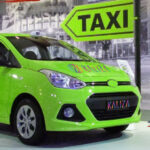
The Sydney store is a “stepping stone” to better things says Lotte Duty Free.
South Korea’s biggest travel retailer, Lotte Duty Free, is ready to resume its plans for global growth, starting in Sydney, Australia where the company will open its first store in the city on Thursday.
Covering more than 32,000 square feet and showcasing hundreds of high-end brands, the three-level store on the corner of Pitt Street and Market Street in the heart of Sydney’s retail precinct has been designed to be a destination in its own right for travelers.
Lotte said the downtown opening marks the “restart of our global business” as well as a “full-fledged entry into the Oceania duty-free market.” Lotte Duty Free CEO Lee Gap commented: “The opening of the Sydney store reflects our will to speed up expansion once again.”
This is the retailer’s first store in about two years, following the launch of the large 90,000 square foot tobacco and liquor concession at Singapore Changi Airport in June 2020. It launched initially as an e-commerce venture as there were no passengers due to Covid-19.
A target of almost $800 million
Lotte means business in Australia. It has set a sales target of just over $790 million (1 trillion Korean won) over 10 years for the new store. Key categories will be beauty, watches and jewelry, and wine and spirits. In a statement, Lotte Duty Free said that it plans to become Australia’s largest duty-free operator by using its downtown Sydney store as a “stepping stone” to growth.
MORE FOR YOU
According to the South Korean retailer, the Australian duty-free market was worth about $800 million annually pre-Covid. Right now, sales are well below that and other competitors in the market such as Dufry, LVMH-owned DFS, and Heinemann, will all be scrambling for business as traveler numbers start to return.
Lotte’s store at Singapore Changi Airport’s Terminal 3 where the South Korean travel retailer has … [+]
Lotte is going to fully capitalize on the international reopening of the Australian market. At Sydney Airport, where Heinemann has the main retail concession—and where luxury brands have held on through the hard times—international traffic in March hit 342,000, a year-on-year uplift of 992%. The rise, though big, merely reflects just how low the market had sunk during the pandemic. For comparison, in March 2019 (pre-Covid) international traffic hit 1.3 million passengers.
A competitor to Sydney Airport
The interiors of Lotte’s new downtown store have been designed by Australian company Bates Smart to be contemporary and inviting. Stephen Timms, CEO of Lotte Duty Free Oceania, commented: “This is a destination in its own right and somewhere we want people to build into their international journeys.”
Given that travelers will be able to browse at their leisure, as opposed to rushing at the airport, the new downtown store will threaten airport sales if travel shoppers prefer to shop downtown with Lotte, where the selection may also be bigger and better.
The South Korean retailer will feature some brands that are new to the Australian travel retail market, for example Japanese-owned beauty brands Pola and Decorté. The average price of cosmetics will be set 15% lower than the local retail price in Australia to give shoppers an incentive.
Meanwhile the focus for alcoholic beverages will be on Australians and New Zealanders who tend to shop this category because liqour duty-free import limits are higher than in many other countries. A resident sommelier will be on hand for wines queries or for sampling, and there will be a whisky bar showcasing 100 different bottles.
Lotte Duty Free is eager to expand outside its home market. (Photo by Chung Sung-Jun/Getty Images)
In the watches department, brands such as Omega, Montblanc, Longines and Mido will be present. When the duty-free market recovers enough, Lotte says it will add “top tier” fashion and jewelry brands in their own boutiques.
Elsewhere in Asia, Lotte Duty Free—which had at one point closed all its 19 overseas stores due to Covid-19—has resumed operations everywhere except for its Cam Ranh Airport store in Nha Trang, Vietnam. Also in Vietnam, the company is planning to open a new shop in Da Nang this year and expects total overseas (non-Korean) sales in 2022 to reach close to $200 million.
With the new Sydney store, Lotte will operate 20 duty-free stores in seven markets: Australia (4), Guam (1), Japan (2), South Korea (8), New Zealand (1), Singapore (1) and Vietnam (3).






